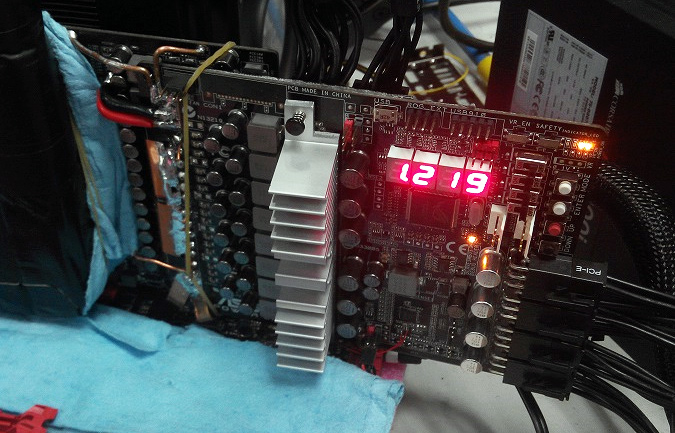Asustek Computer is working on external voltage regulator module (VRM) card for graphics cards that will enable extreme overclocking by allowing massive overvoltage. Asus follows EVGA and Gigabyte Technology who have been selling similar external VRM solutions for years now.
Although a lot of modern graphics cards (e.g., Asus Strix GeForce GTX 980, Asus ROG Matrix Platinum GTX 980) have very sophisticated 10-phase or even 14-phase VRMs that provide excellent overclocking potential, they are still commercial products with overvoltage protection and other restrictions. External VRM cards remove all limitations and allow to boost voltages of GPU and memory to incredible levels.
Elmor, an overclocker with the SweClockers.com team who managed to overclock Nvidia GeForce GTX 980 to 2.20GHz earlier this year, has published an image of Asus ROG Ext external VRM card for graphics cards at Hwbot forums, a leading resource for overclockers and modders. The card is an experimental project, so far only a number of test samples have been made and shipped out to overclockers working with Asus. It is unclear whether the company will actually sell this solution to end-users.
The card, which is compatible with a wide range of graphics adapters, features single 8-phase output with output voltage of up to 2.5V (with output voltage offset switches [+0.4V, +0.3V, +0.2V, +0.1V]) and current up to 500A. The card has on-board voltage control/monitoring, output current monitoring, VRM temperature monitoring, load-line calibration (0%, 60%, 80%, 100%), hotwire setting/monitoring and other features required by extreme overclockers. The board sports four six-pin PCIe (4*75W) input power connectors, which means that it can deliver up to 300W of power to the graphics board, enough power to break world’s records.
Formally, capabilities of the external VRM card exceed those of EVGA’s Epower Board 2.0. However, keeping in mind that to accelerate GeForce GTX 980 (GM204) graphics processing unit to 2.20GHz earlier this year professional overclockers needed to increase GPU voltages to just over 1.2V with liquid nitrogen cooling (LN2), the ability to crank up GPU Vcore to something like 2.5V by far exceeds everything that any modern GPU can sustain.
Discuss on our Facebook page, HERE.
KitGuru Says: A key thing about external VRM cards is that once you use one of them, you lose warranty since you essentially modify your graphics board. If you are an extreme enthusiast, this could be acceptable, but for personal use in games such boards are useless. The only reason why one might need an external VRM for graphics card is a hardcore experiment with GPU overvoltage, which involves liquid nitrogen or even liquid helium usage. Given that no graphics card allows to set GPU Vcore higher than 1.3V and “safe” voltages under LN2 are in the range between 1.5V – 1.6V, there is a lot you can do with such cards if you are an extreme enthusiast…
 KitGuru KitGuru.net – Tech News | Hardware News | Hardware Reviews | IOS | Mobile | Gaming | Graphics Cards
KitGuru KitGuru.net – Tech News | Hardware News | Hardware Reviews | IOS | Mobile | Gaming | Graphics Cards



